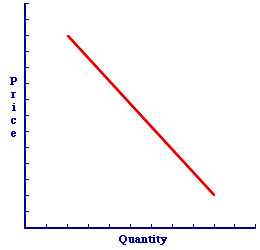
|
|
OPEN MARKET: A market, not unlike that stock market, that trades the U.S. Treasury securities that comprises the federal debt. U.S. Treasury securities are low risk and extremely secure financial instruments that are held by all sorts of investors, especially commercial banks. The Federal Reserve System is also a major holder of U.S. Treasury securities and participant in the open market. In fact, the Federal Reserve System used buying and selling of U.S. Treasury securities through the open market as a means of controlling the money, through what is appropriately termed open market operations.
Visit the GLOSS*arama
|
|


|

|
                           SUBSTITUTE-IN-CONSUMPTION: One of two (or more) goods that provide the same basic satisfaction of a want or need when consumed. A substitute-in-consumption is one of two alternatives falling within the other prices determinant of demand. The other is a complement-in-consumption. An increase in the price of one substitute good causes an increase in demand for the other. A substitute-in-consumption has a positive cross elasticity of demand. Substitutes-in-consumption are two or more goods that satisfy the same wants or needs. Consuming one good means that buyers have no need to consume another. Buy one or buy the other, but not both.The need for food can be satisfied by consuming pizza or fried chicken. The need for transportation can be satisfied by buying a sport utility vehicle or a motorcycle. The desire for entertainment can be satisfied by watching a movie or attending a live theatrical performance. The price of a substitute-in-consumption is part of the other prices demand determinant. A change in the price of a substitute-in-consumption causes a change in demand and a shift of the demand curve. - An increase in the price of one substitute good causes an increase in demand for the other.
- A decrease in the price of one substitute good causes a decrease in demand for the other.
Shifting the Demand CurveTo illustrate this process consider two tasty substitute beverages--OmniCola and King Caffeine. Each provides comparable satisfaction to thirsty consumers. They buy one or they buy the other.| Substitute-in-Consumption |  |
How is the demand for OmniCola affected if the price of King Caffeine should change?- A Higher Price: Suppose the price of King Caffeine increases. Thirsty consumers making a beverage selection undoubtedly react according to the law of demand and decrease the quantity demanded of King Caffeine. However, in that consumers remain thirsty, they are bound to seek out a substitute beverage, such as OmniCola. The result is an increase in the demand for OmniCola and a rightward shift of the demand curve. Click the [Price Increase] button to demonstrate.
The beverage substitution between King Caffeine and OmniCola is due to a change in relative prices triggered by the change in the price of King Caffeine, given that the price of OmniCola remains constant. That is, even though the price of OmniCola does not change, it is relatively cheaper due to the higher price of King Caffeine.
- A Lower Price: Suppose the price of King Caffeine decreases. Thirsty consumers making a beverage selection now undoubtedly react according to the law of demand and increase the quantity demanded of King Caffeine. However, in that consumers are satisfying their thirst with King Caffeine, they are unlikely to buy as much of the substitute beverage, OmniCola. As such, the demand for OmniCola decreases and a leftward shift of the demand curve. Click the [Price Decrease] button to demonstrate.
The beverage substitution between King Caffeine and OmniCola is once again due to a change in relative prices triggered by the price of King Caffeine, with no change in the price of OmniCola. That is, even though the price of OmniCola does not change, it is relatively more expensive due to the lower price of King Caffeine.
Cross ElasticityClassifying a good as a substitute-in-consumption is accomplished in a precise manner using the cross elasticity of demand. The cross elasticity of demand is the relative response of the demand for one good to changes in the price of another good. More specifically, it is the percentage change in the demand of one good due to a percentage change in the rice of another good. A substitute-in-consumption is then one with a cross elasticity that is positive, or greater than zero. In comparison, a complement-in-consumption has a negative cross elasticity, or less than zero.

Recommended Citation:SUBSTITUTE-IN-CONSUMPTION, AmosWEB Encyclonomic WEB*pedia, http://www.AmosWEB.com, AmosWEB LLC, 2000-2025. [Accessed: July 18, 2025].
Check Out These Related Terms... | | | | | | | |
Or For A Little Background... | | | | | | | | | |
And For Further Study... | | | | | | | | | | |
Search Again?
Back to the WEB*pedia
|



|

|
PINK FADFLY
[What's This?]
Today, you are likely to spend a great deal of time calling an endless list of 800 numbers wanting to buy either a weathervane with a cow on top or a box of multi-colored, plastic paper clips. Be on the lookout for high interest rates.
Your Complete Scope
This isn't me! What am I?
|

|
|
A half gallon milk jug holds about $50 in pennies.
|

|
|
"A winner is someone who recognizes his God-given talents, works his tail off to develop them into skills, and uses those skills to accomplish his goals. " -- Larry Bird, basketball player
|

|
BJE
Bell Journal of Economics
|

|
|
Tell us what you think about AmosWEB. Like what you see? Have suggestions for improvements? Let us know. Click the User Feedback link.
User Feedback
|


|


